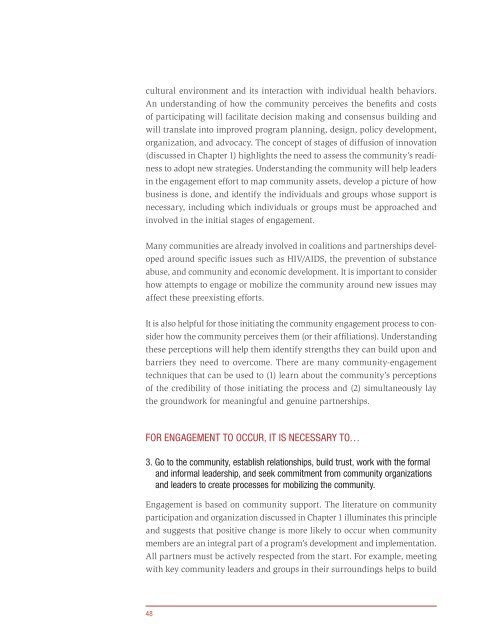Principles of Community Engagement (Second Edition)
Principles of Community Engagement (Second Edition)
Principles of Community Engagement (Second Edition)
Create successful ePaper yourself
Turn your PDF publications into a flip-book with our unique Google optimized e-Paper software.
cultural environment and its interaction with individual health behaviors<br />
An understanding <strong>of</strong> how the community perceives the benefits and costs<br />
<strong>of</strong> participating will facilitate decision making and consensus building and<br />
will translate into improved program planning, design, policy development,<br />
organization, and advocacy The concept <strong>of</strong> stages <strong>of</strong> diffusion <strong>of</strong> innovation<br />
(discussed in Chapter 1) highlights the need to assess the community’s readiness<br />
to adopt new strategies Understanding the community will help leaders<br />
in the engagement effort to map community assets, develop a picture <strong>of</strong> how<br />
business is done, and identify the individuals and groups whose support is<br />
necessary, including which individuals or groups must be approached and<br />
involved in the initial stages <strong>of</strong> engagement<br />
Many communities are already involved in coalitions and partnerships developed<br />
around specific issues such as HIV/AIDS, the prevention <strong>of</strong> substance<br />
abuse, and community and economic development It is important to consider<br />
how attempts to engage or mobilize the community around new issues may<br />
affect these preexisting efforts<br />
It is also helpful for those initiating the community engagement process to consider<br />
how the community perceives them (or their affiliations) Understanding<br />
these perceptions will help them identify strengths they can build upon and<br />
barriers they need to overcome There are many community-engagement<br />
techniques that can be used to (1) learn about the community’s perceptions<br />
<strong>of</strong> the credibility <strong>of</strong> those initiating the process and (2) simultaneously lay<br />
the groundwork for meaningful and genuine partnerships<br />
FOR ENGAGEMENT TO OCCUR, IT IS NECESSARY TO…<br />
3. Go to the community, establish relationships, build trust, work with the formal<br />
and informal leadership, and seek commitment from community organizations<br />
and leaders to create processes for mobilizing the community.<br />
<strong>Engagement</strong> is based on community support The literature on community<br />
participation and organization discussed in Chapter 1 illuminates this principle<br />
and suggests that positive change is more likely to occur when community<br />
members are an integral part <strong>of</strong> a program’s development and implementation<br />
All partners must be actively respected from the start For example, meeting<br />
with key community leaders and groups in their surroundings helps to build<br />
48

















